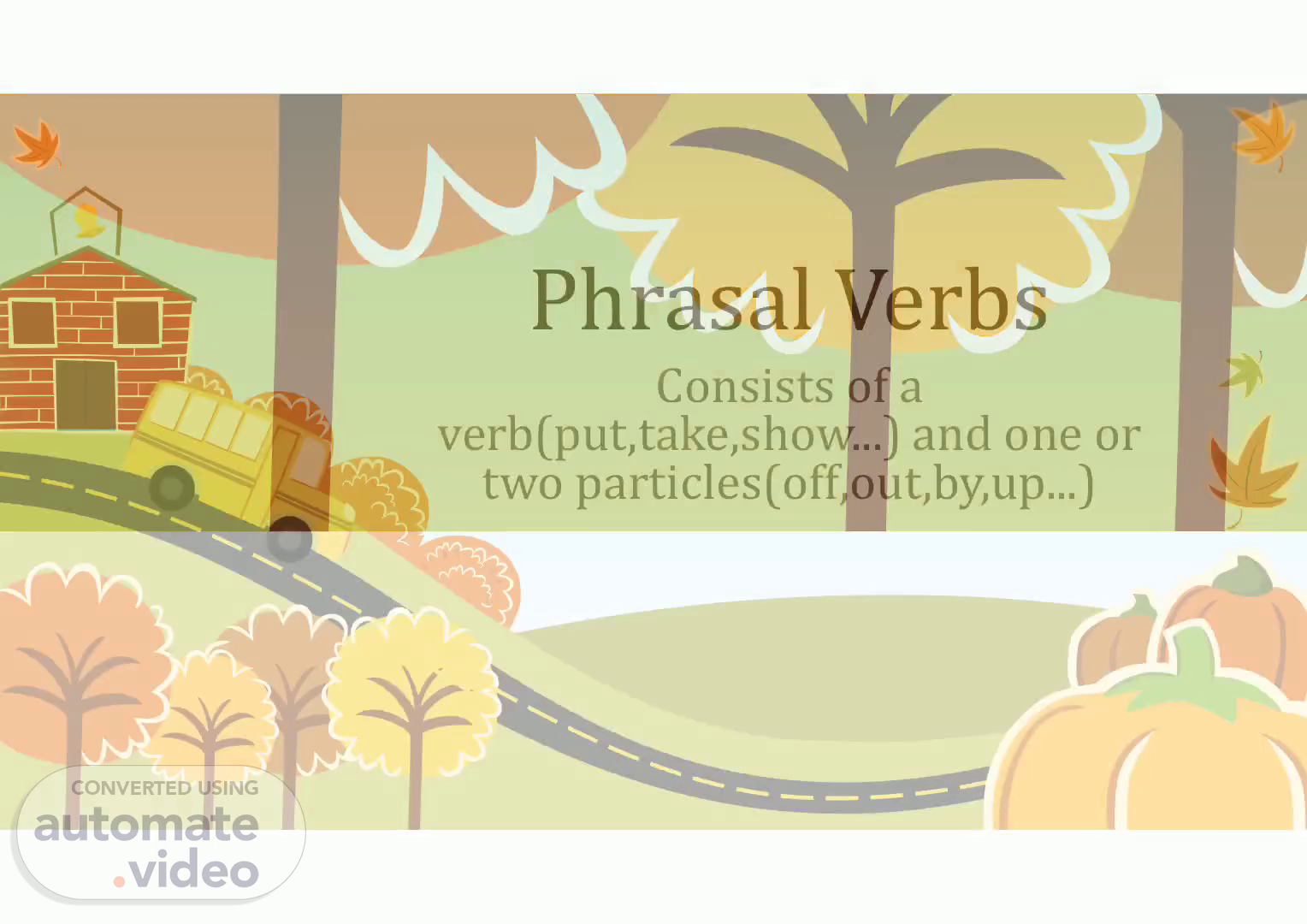
36765_PDF_467ee6c1-ba3c-4bc7-b549-f75fcea28d04
Scene 1 (0s)
[Audio] Welcome everyone to our presentation on Phrasal Verbs! Today, we will be discussing how verbs and particles come together to give us a great way to express ideas in English. We will look at some examples, explore the different types of phrasal verbs, and discuss how you can use them in your own writing. Let's get started!.
Scene 2 (22s)
[Audio] Phrasal verbs consist of a verb and one or two particles. 'Come in' and 'arrive' are examples of intransitive phrasal verbs without an object. Meanwhile, 'write something down' and 'write something on paper' are examples of phrasal verbs that can be separated by an object. Lastly, those that cannot be separated by an object include 'look after' and 'look after the baby'. Knowing the three categories of phrasal verbs is essential to fully comprehend their grammar..
Scene 3 (56s)
[Audio] Phrasal Verbs are a topic of conversation today. A phrasal verb consists of a verb and one or two particles. Let's use check in and look up as examples. Checking in is the process of going to a desk at an airport or hotel and informing an official that you have arrived. If you need to check in before 8.00, you now know what to do. As for look up, it usually means that something is improving. For example, if business was not doing well but now it is looking up, it means the situation is improving. This covers what is needed to know about phrasal verbs..
Scene 4 (1m 39s)
[Audio] Phrasal verbs are an important element of the English language, consisting of a verb and one or multiple particles. 'Show up' is an example, meaning to come to where someone is waiting. As an illustration, you would say "She didn't show up till the next morning". Another example is 'write down', meaning to jot something on paper. You can say "She wrote down his name" or "She wrote down everything she could remember about him". When the object is a long phrase, it normally follows the phrasal verb, like "She wrote down it.
Scene 5 (2m 16s)
[Audio] Phrasal verbs are very prevalent in English and they can provide a boost to expand your language. In this slide, two of them are going to be discussed. 'Look something up' implies to search for data in a book or on the web. As an example, you could say "I had to look the word up". The other phrasal verb is 'make something up'. This implies to create a narrative or interpretation for something. For instance, you might declare "I didn't want to see him, so I made up an excuse and left." Being familiar with these two phrasal verbs will help you to become more accomplished in English..
Scene 6 (2m 58s)
[Audio] Phrasal verbs are a frequent part of English and can be very beneficial in daily conversation. This slide will review two of the more popular phrasal verbs: "try something on" and "look after something or someone". To use "try on", we would employ it when we wish to verify if a garment fits us or looks good on us. For example, "I tried the jacket on but it was too small". To utilize the verb "look after", it is used to express the task of taking care of someone or something. For example, "He looked after the baby" as well as "He looked the baby after". These examples just scratch the surface of the plentiful phrasal verbs in English. Practicing using them in context is recommended to become a proficient speaker..
Scene 7 (3m 51s)
[Audio] Phrasal verbs can significantly improve our English vocabulary. For example, to "look into something" means to analyze and search for information concerning a problem, such as a criminal case or an issue. If someone asked you to complain to an airline, they may respond by saying they will look into it, which denotes that they will examine the complaint. Additionally, the phrase "come across something or someone" implies that you met somebody or encountered something by accident. For instance, when reading an article, if you suddenly find a word you are unfamiliar with, then you could say you have come across it. Practicing phrasal verbs can enable us to access a higher level of English fluency. Incorporate these phrases into your speaking and writing to sound like a native speaker..
Scene 8 (4m 42s)
[Audio] Phrasal verbs consist of a verb and one or two particles. "Stand for" is an example of this, meaning to represent or mean something. "Go out with somebody" is another example, meaning to spend time with them and have a romantic relationship. Make use of this knowledge in your conversations and writing!.
Scene 9 (5m 4s)
[Audio] Phrasal verbs are an important part of English grammar. They consist of a verb and one or two particle words. An example is 'cut back on something', which is used to lower the amount of something that you consume, spend, or use. For instance, 'I must cut back on sweets to try and lose weight.' See how this expression fits into your conversations today..
Scene 10 (5m 29s)
[Audio] We're discussing phrasal verbs today. A phrasal verb is a combination of a verb and one or more particles. An example of this is 'smile up', which means 'to become happy'. To further familiarize yourself with phrasal verbs, take a look at iSLCollective.com. It's a great way to increase your English vocabulary. That's all we have on this slide - let's move on to the next one..
Scene 11 (5m 59s)
g.smiles. iSLCollective.com.